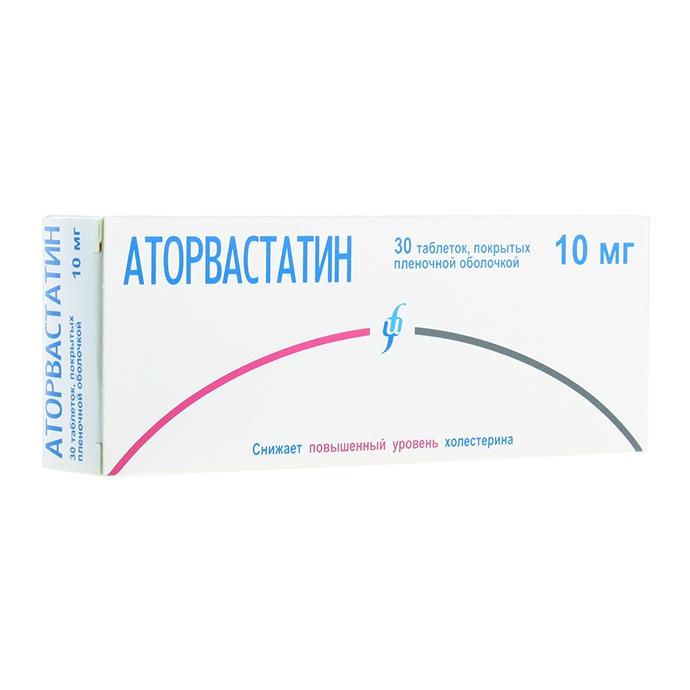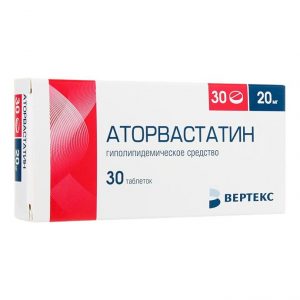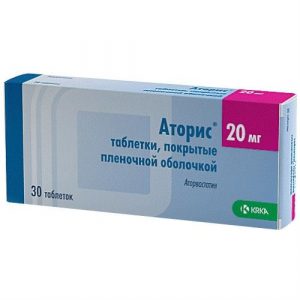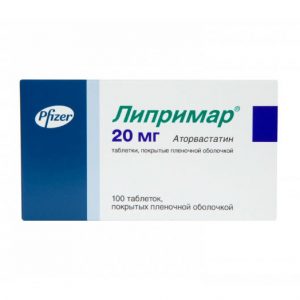Description
Release form
Tablets, film-coated white or almost white, round, biconvex in cross section – the core is white or almost white.
Pharmacological action
Clinical and pharmacological group: Hypolipidemic drug.
Pharmacotherapeutic group: Hypolipidemic agent – HMG-CoA reductase inhibitor.
Pharmacological action
Hypolipidemic agent from the group of statins. According to the principle of competitive antagonism, the statin molecule binds to that part of the coenzyme A receptor where HMG-CoA reductase is attached. Another part of the statin molecule inhibits the conversion of hydroxymethylglutarate to mevalonate, an intermediate in the synthesis of cholesterol molecules. Inhibition of the activity of HMG-CoA reductase leads to a series of sequential reactions, as a result of which the intracellular cholesterol content is reduced and there is a compensatory increase in the activity of LDL receptors and, accordingly, acceleration of the catabolism of LDL cholesterol (Xc).
The hypolipidemic effect of statins is associated with a decrease in total cholesterol due to LDL cholesterol. The decrease in LDL is dose-dependent and is not linear, but exponential. The inhibitory effect of atorvastatin against HMG-CoA reductase is approximately 70% determined by the activity of its circulating metabolites.
Statins do not affect the activity of lipoprotein and hepatatic lipases, do not significantly affect the synthesis and catabolism of free fatty acids, therefore, their effect on the level of TG is secondary and mediated through their main effects in lowering LDL-C. A moderate decrease in TG levels with statin treatment appears to be associated with the expression of remnant (apo E) receptors on the surface of hepatocytes involved in the catabolism of STDs, which comprise about 30% TG. Compared to other statins (with the exception of rosuvastatin), atorvastatin causes a more pronounced decrease in TG levels.
In addition to lipid-lowering effects, statins have a positive effect on endothelial dysfunction (preclinical sign of early atherosclerosis), on the vascular wall, atheroma state, improve blood rheological properties, have antioxidant, antiproliferative properties.
Atorvastatin lowers cholesterol in patients with homozygous familial hypercholesterolemia, which is usually not amenable to hypolipidemic therapy.
Pharmacokinetics
Atorvastatin is rapidly absorbed from the digestive tract. Absolute bioavailability is low – about 12%, due to the presystemic clearance in the gastrointestinal mucosa and / or due to the first passage through the liver, mainly at the site of action.
Atorvastatin is metabolized with the participation of the CYP3A4 isoenzyme to form a number of substances that are inhibitors of HMG-CoA reductase.
T1 / 2 from plasma is about 14 hours, although the T1 / 2 inhibitor of HMG-CoA reductase activity is approximately 20-30 hours, which is due to the participation of active metabolites.
Plasma protein binding is 98%.
Atorvastatin is excreted in the form of metabolites mainly with bile.
Indications
Primary hypercholesterolemia with diet therapy failure
Combined hypercholesterolemia and hypertriglyceridemia
Heterozygous and homozygous familial hypercholesterolemia with diet therapy failure.
Contraindications
If you have one of these diseases, be sure to consult your doctor before taking the drug.
– Hypersensitivity to the drug (to any of the components of the drug), as well as to other statin drugs (HMG-CoA reductase inhibitors) in the history of
– liver disease in the active phase,
persistent increase in the activity of liver enzymes of unknown etiology
– skeletal muscle disease (myopathy)
– pregnancy and lactation
– simultaneous use with strong inhibitors of the isoenzyme CYP3A4 (itraconazole, voriconazole, teleconazole, ketoronezone, ketonecreazone, ketonecreazone, ketonecreazone, ketonecazone rum, erythromycin, clarithromycin, telithromycin and nefazodone, preparations containing cobicistat)
– concomitant treatment with gemfibrozil, cyclosporine or danazole
– n lactose intolerance, lactase deficiency and glucose-galactose malabsorption syndrome.
– Pediatric Use In children and adolescents under the age of 18, the safety and effectiveness of Simvastatin Alkaloid have not been established.
Precautions:
Precautions: not using reliable contraceptives
Hypersensitivity to atorvastatin.
Use during pregnancy and lactation
Atorvastatin is contraindicated in pregnancy and lactation (breastfeeding).
It is not known whether atorvastatin is excreted in breast milk. Given the possibility of adverse events in infants, if necessary, use of the drug during lactation should decide on the termination of breastfeeding.
Women of reproductive age should use adequate contraceptive methods during treatment. Atorvastatin can be used in women of reproductive age only if the probability of pregnancy is very low, and the patient is informed about the possible risk of treatment for the fetus.
Composition
Active substances:
Atorvastatin 10 mg.
Excipients:
Microcrystalline cellulose – 52.52 mg
Pregelatinized corn starch – 52.51 mg
Colloidal silicon dioxide – 0.38 mg
Magnesium carbonate – 33 mg
Magnesium stearate – 0.75 mg.
Dosage and administration
Treatment is carried out against a standard diet for patients with hypercholesterolemia. The dose is set individually, depending on the initial level of cholesterol. Take inside. The initial dose is usually 10 mg 1 time / day. The effect manifests itself within 2 weeks, and the maximum effect – within 4 weeks. If necessary, the dose can be gradually increased with an interval of 4 weeks or more. The maximum daily dose is 80 mg.
Side effects of the
From the nervous system:> 1% – insomnia, dizziness <1% - headache, asthenia, malaise, drowsiness, nightmares, paresthesia, peripheral neuropathy, amnesia, emotional lability, ataxia, paralysis, paralysis , migraine, depression, hypesthesia, loss of consciousness. On the part of the sensory organs: <1% - amblyopia, tinnitus, dry conjunctiva, disturbed accommodation, hemorrhage in the retina, deafness, glaucoma, parosmia, loss of taste, perversion of taste. From the cardiovascular system:> 1% – chest pain <1% - palpitations, vasodilation symptoms, orthostatic hypotension, increased blood pressure, phlebitis, arrhythmia, angina pectoris. From the hemopoietic system: <1% - anemia, lymphadenopathy, thrombocytopenia. From the respiratory system:> 1% – bronchitis, rhinitis <1% - pneumonia, dyspnea, exacerbation of bronchial asthma, nosebleeds. From the digestive system:> 1% – nausea <1% - heartburn, constipation or diarrhea, flatulence, gastralgia, abdominal pain, decreased or increased appetite, dry mouth, belching, dysphagia, vomiting, stomatitis, esophagitis, glossitis, erosive and ulcerative lesions of the oral mucosa, gastroenteritis, hepatitis, biliary colic, cheilitis, duodenal ulcer, pancreatitis, cholestatic jaundice, impaired liver function, rectal bleeding, melena, bleeding gums, tenesmus. From the musculoskeletal system:> 1% – arthritis <1% - leg muscle cramps, bursitis, tendosynovitis, myositis, myopathy, arthralgia, myalgia, rhabdomyolysis, torticollis, muscle hypertonicity, joint contracture, joint swelling, tendonopathy (in some cases with tendon rupture). From the genitourinary system:> 1% – urogenital infections, peripheral edema <1% - dysuria (including pollakiuria, nocturia, urinary incontinence or urinary retention, mandatory urination), leukocyturia, nephritis, hematuria, vaginal bleeding , nephrourolithiasis, metrorrhagia, epididymitis, decreased libido, impotence, impaired ejaculation. Dermatological reactions:> 1% – alopecia, xeroderma, photosensitivity, increased sweating, eczema, seborrhea, ecchymosis, petechiae.
From the endocrine system: <1% - gynecomastia, mastodynia. From the side of metabolism: <1% - increase in body weight, exacerbation of gout. Allergic reactions: <1% - itchy skin, rash, contact dermatitis, rarely - urticaria, angioedema, facial edema, anaphylaxis, erythema multiforme exudative (including Stevens-Johnson syndrome), toxic epidermal necrolysis (Lyell syndrome ) Laboratory indicators: <1% - hyperglycemia, hypoglycemia, increased serum CPK, albuminuria. Drug interaction With the simultaneous use of atorvastatin with digoxin, the concentration of digoxin in the blood plasma slightly increases. Diltiazem, verapamil, isradipine inhibit the isoenzyme of CYP3A4, which is involved in the metabolism of atorvastatin, therefore, with the simultaneous use of calcium channel blockers, it is possible to increase the concentration of atorvastatin in the blood plasma and increase the risk of Active ingredient Atorvastatin pharmacy terms for lekarstvennaja form tablets Appointment for Adults on purpose doctor Indications Influenza prophylaxis, ARVI, Influenza pf40 Atherosclerosis Izvarino Pharma, Russia




